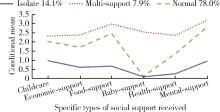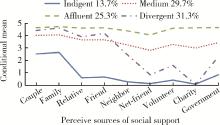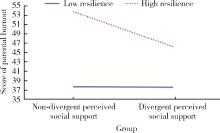北京大学学报(医学版) ›› 2022, Vol. 54 ›› Issue (3): 520-525. doi: 10.19723/j.issn.1671-167X.2022.03.018
新型冠状病毒肺炎疫情下儿童父母社会支持与养育倦怠的关系
- 北京大学公共卫生学院卫生政策与管理系,北京 100191
Relationship between social support and parental burnout in COVID-19 among Chinese young parents
Ming-long CHEN,Xiao-han LIU,jing GUO*( )
)
- Department of Health Policy and Management, Peking University School of Public Health, Beijing 100191, China
摘要:
目的: 探讨新型冠状病毒肺炎疫情下儿童父母社会支持潜在类型,并分析社会支持与养育倦怠的关系。方法: 2020年4月采用自制问卷及量表对1~10岁儿童父母进行网络调查,应用潜在剖面分析方法对父母获得社会支持、感知社会支持进行分析,将得到的社会支持类别分别作为自变量,将父母养育倦怠作为因变量,进行多元回归分析,探索获得社会支持、感知社会支持与养育倦怠之间的关系,并探讨了抗逆力在社会支持组别与养育倦怠间的调节作用。结果: 父母获得社会支持分为孤立型(14.1%)、正常型(78.0%)、多助型(7.9%)三种;父母感知社会支持分为贫乏型(13.7%)、中等型(29.7%)、富足型(25.3%)、分歧型(31.3%)四种,其中分歧型感知社会支持的父母具有更多的感知来自伴侣、家人、亲戚的社会支持,而较少的感知来自网友、社会组织以及政府的社会支持的特征。回归分析结果显示,获得社会支持的不同组别与父母倦怠情绪的相关没有统计学意义,感知社会支持组别中,贫乏型与分歧型的社会支持与父母倦怠相关存在统计学意义(β=-0.120,P=0.003)。相较于贫乏型,分歧型父母的养育倦怠程度更低。同时,抗逆力对分歧型感知社会支持与养育倦怠有调节作用,相较于低抗逆力父母,高抗逆力父母感知分歧型社会支持会有更低的养育倦怠。结论: 新型冠状病毒肺炎疫情下父母获得社会支持、感知社会支持存在多种类别,感知更多传统近端社会支持(来自伴侣、家人和朋友)的儿童父母会有相对更低的养育倦怠风险、更高的抗逆力父母会对近端熟人支持更敏感,能更好的抵御养育倦怠情绪。
中图分类号:
- R193.3
| 1 | Huang Y , Zhao N . Corrigendum to generalized anxiety disorder, depressive symptoms and sleep quality during COVID-19 outbreak in China: a web-based cross-sectional survey[J]. Psychiatry Res, 2021, 299 (4): 113803. |
| 2 |
Rajkumar RP . COVID-19 and mental health: a review of the exis-ting literature[J]. Asian J Psychiatr, 2020, 52, 102066.
doi: 10.1016/j.ajp.2020.102066 |
| 3 | Adams E , Smith D , Caccavale LJ , et al. Parents are stressed! Factors that influence parenting during COVID-19[J]. Ann Behav Med, 2021, 55, S340. |
| 4 |
Lindstr MC , Man J , Norberg AL . Parental burnout in relation to sociodemographic, psychosocial and personality factors as well as disease duration and glycaemic control in children with type 1 diabetes mellitus[J]. Acta Paediatrica, 2011, 100 (7): 1011- 1017.
doi: 10.1111/j.1651-2227.2011.02198.x |
| 5 |
Aunola K , Sorkkila M , Tolvanen A . Validity of the finnish version of the parental burnout assessment (PBA)[J]. Scand J Psychol, 2020, 61 (5): 714- 722.
doi: 10.1111/sjop.12654 |
| 6 |
Gariepy G , Honkaniemi H , Quesnel-Vallee A . Social support and protection from depression: systematic review of current findings in Western countries[J]. Br J Psychiatry, 2016, 209 (4): 284- 293.
doi: 10.1192/bjp.bp.115.169094 |
| 7 | Hou J , Yu Q , Lan X . COVID-19 infection risk and depressive symptoms among young adults during quarantine: the moderating role of grit and social support[J]. Psychiatry Res, 2021, 11, 577942. |
| 8 |
Wise AE , Smith BC , Armelie AP , et al. Age moderates the relationship between source of social support and mental health in racial minority lesbian, gay, and bisexual youth[J]. J Health Psychol, 2019, 24 (7): 888- 897.
doi: 10.1177/1359105316686667 |
| 9 |
Roskam I , Brianda ME , Mikolajczak M . A step forward in the conceptualization and measurement of parental burnout: the parental burnout assessment (PBA)[J]. Front Psychol, 2018, 9, 758.
doi: 10.3389/fpsyg.2018.00758 |
| 10 |
Tian J , Hong JS . Validation of the Chinese version of the resi-lience scale and its cutoff score for detecting low resilience in Chinese cancer patients[J]. Support Care Cancer, 2013, 21 (5): 1497- 1502.
doi: 10.1007/s00520-012-1699-x |
| 11 |
Spurk D , Hirschi A , Wang M , et al. Latent profile analysis: a review and "how to" guide of its application within vocational beha-vior research[J]. J Vocat Behav, 2020, 120, 103445.
doi: 10.1016/j.jvb.2020.103445 |
| 12 | 黎熙元, 陈福平. 社区论辩: 转型期中国城市社区的形态转变[J]. 社会学研究, 2008, 23 (2): 192- 217.192-217, 246 |
| 13 | 程华斌, 刘霞, 李艺敏, 等. 养育是一种幸福的体验吗? 养育倦怠述评[J]. 心理发展与教育, 2021, 37 (1): 146- 152. |
| 14 | Gromada A, Richardson D, Rees G. Childcare in a global crisis: the impact of COVID-19 on work and family life[J]. (2020-06-12)[2021-03-16]. http://www.cokmed.net/ps-sistem/dosyalar/kutuphane/Childcare%20in%20Global%20Crisis%20-%20Impact%20of%20Covid-19%20on%20Work%20and%20Family%20Life.pdf. |
| 15 | 乔倩倩, 贾志科. "抗逆力"研究现状述评与展望[J]. 社会工作, 2014, 16 (5): 140- 149.140-149, 156 |
| 16 |
Howie-Davies R , McKenzie K . Diagnosis, information and stress in parents of children with a learning disability[J]. Learn Disabil P, 2007, 10 (8): 28- 33.
doi: 10.7748/ldp2007.10.10.8.28.c4281 |
| 17 |
Hauser-Cram P , Warfield ME , Shonkoff JP , et al. Children with disabilities: a longitudinal study of child development and parent well-being[J]. Monogr Soc Res Child Dev, 2001, 66 (3): 1- 11.
doi: 10.1111/1540-5834.00151 |
| 18 |
叶俊杰. 领悟社会支持、实际社会支持与大学生抑郁[J]. 心理科学, 2006, 29 (5): 1141- 1143.1141-1143, 1131
doi: 10.3969/j.issn.1671-6981.2006.05.027 |
| 19 | 熊峰, 林涌波, 周静, 等. 常态化疫情防控下医务人员职业倦怠与社会支持相关性分析[J]. 公共卫生与预防医学, 2021, 32 (4): 113- 115. |
| 20 |
Shepherd D , Goedeke S , Landon J , et al. The types and functions of social supports used by parents caring for a child with autism spectrum disorder[J]. J Autism Dev Disord, 2020, 50 (4): 1337- 1352.
doi: 10.1007/s10803-019-04359-5 |
| 21 |
王波, 王倩. 特殊儿童父母养育倦怠研究进展[J]. 中国特殊教育, 2021, 28 (7): 26- 32.
doi: 10.3969/j.issn.1007-3728.2021.07.006 |
| [1] | 付子苑, 杨菲, 周末, 李昕璇, 王若凝, 崔宁轩, 黄敬, 张艺馨, 蒋华芳, 郭玉华, 周虹. 潍坊市婴儿母亲回应性照护行为的影响因素[J]. 北京大学学报(医学版), 2025, 57(3): 481-486. |
| [2] | 蔡珊,张依航,陈子玥,刘云飞,党佳佳,师嫡,李佳欣,黄天彧,马军,宋逸. 北京市中小学生身体活动时间现状及影响因素的路径[J]. 北京大学学报(医学版), 2024, 56(3): 403-410. |
| [3] | 李建斌,吕梦娜,池强,彭一琳,刘鹏程,吴锐. 干燥综合征患者发生重症新型冠状病毒肺炎的早期预测[J]. 北京大学学报(医学版), 2023, 55(6): 1007-1012. |
| [4] | 赖金惠,王起,姬家祥,王明瑞,唐鑫伟,许克新,徐涛,胡浩. 新型冠状病毒肺炎疫情期间延迟拔除输尿管支架对泌尿系结石术后患者生活质量和心理状态的影响[J]. 北京大学学报(医学版), 2023, 55(5): 857-864. |
| [5] | 康志宇,王磊磊,韩永正,郭向阳. 北京冬季奥林匹克运动会运动员手术的麻醉管理[J]. 北京大学学报(医学版), 2022, 54(4): 770-773. |
| [6] | 陈平,黎泽明,郭怡,孙昕霙,Edwin B.FISHER. 基于大五人格理论应用潜在剖面分析探究2型糖尿病患者的用药依从性[J]. 北京大学学报(医学版), 2021, 53(3): 530-535. |
| [7] | 李秋钰,程秦,赵志伶,代妮妮,曾琳,朱兰,郭炜,李超,王军红,李姝,葛庆岗,沈宁. 肾移植术后感染新型冠状病毒1例[J]. 北京大学学报(医学版), 2020, 52(4): 780-784. |
| [8] | 杨航,杨林承,张瑞涛,凌云鹏,葛庆岗. 合并高血压、冠心病、糖尿病的新型冠状病毒肺炎患者发生病死的危险因素分析[J]. 北京大学学报(医学版), 2020, 52(3): 420-424. |
| [9] | 陈美恋,高燕,郭维,左力,王天兵. 新型冠状病毒肺炎患者床旁血液净化治疗的感染防控[J]. 北京大学学报(医学版), 2020, 52(3): 414-419. |
| [10] | 张旭熙,吴士艳,王冯彬,玛依努尔·于苏甫,孙凯歌,胡康,张幸,孙昕霙,Edwin B. FISHER. 社区糖尿病患者获得社会支持与自我管理行为的相关关系[J]. 北京大学学报(医学版), 2017, 49(3): 455-461. |
|
||






